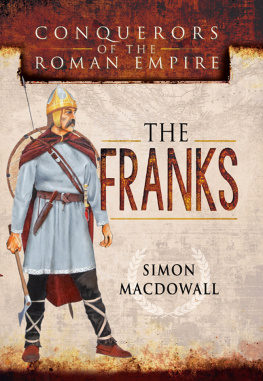
The Goths
The Goths
Conquerors of the Roman Empire
Simon MacDowall
First published in Great Britain in 2017 by
Pen & Sword Military
an imprint of
Pen & Sword Books Ltd
47 Church Street
Barnsley
South Yorkshire
S70 2AS
Copyright Simon MacDowall, 2017
ISBN 978-1-47383-764-5
eISBN 978-1-47388-963-7
Mobi ISBN 978-1-47388-962-0
The right of Simon MacDowall to be identified as Author of this Work
has been asserted by them in accordance with the Copyright, Designs and
Patents Act 1988.
A CIP catalogue record for this book is available from the British Library
All rights reserved. No part of this book may be reproduced or
transmitted in any form or by any means, electronic or mechanical
including photocopying, recording or by any information storage and
retrieval system, without permission from the Publisher in writing.
Pen & Sword Books Ltd incorporates the Imprints of Pen & Sword Aviation,
Pen & Sword Maritime, Pen & Sword Military, Wharncliffe Local History,
Pen and Sword Select, Pen and Sword Military Classics, Leo Cooper,
Remember When, Seaforth Publishing and Frontline Publishing.
For a complete list of Pen & Sword titles please contact
PEN & SWORD BOOKS LIMITED
47 Church Street, Barnsley, South Yorkshire, S70 2AS, England
E-mail:
Website: www.pen-and-sword.co.uk
List of Plates
Barbarian prisoner from the Arch of Diocletian. (Deutsches Archologisches Institut Rome)
A scene from the Ludovisi sarcophagus depicting a Roman victory over the Goths in the mid-third century. (National Roman Museum)
The insignia of the Magister Militum per Thracias showing the shield designs of the units under his command. ( Notitia Dignitatum , Oxford Manuscript)
Shield designs belonging to the Roman auxiliary units of the Visi and . ( Notitia Dignitatum , Oxford Manuscript)
The mausoleum of the Empress Galla Placidia in Ravenna. (Authors photo)
The treasure of Pouan, found near the 451 AD battlefield of the Catalaunian Fields. (Muse Saint-Loup, Troyes)
Soldiers on the base of the Obelisk of Theodosius in the Hippodrome of Constantinople. (Authors photo)
The belt buckle of Saint Caesarius, Bishop of Arles from 502-542. (Authors photo Muse de lArles antique)
The signet ring of Alaric II the king of the . (Vienna Kunsthistorisches Museum)
Spanish re-enactors equipped as typical late Roman cavalry. (Photo by Javier Gmez Valero)
A rare surviving example of a Visigothic sword and scabbard. (Authors photo National Archeological Museum, Madrid)
A small collection of Visigothic spear and arrow heads and daggers in the Museum of Visigothic Culture, Toledo. (Authors photo)
A pair of gold and garnet Visigothic broaches. (Authors photo National Archeological Museum, Madrid)
Detail from the Ashburnham Pentateuch. The dress and appearance of the figures could be that of sixth century Visigoths. (Bibliothque Nationale de France)
Detail from the Ashburnham Pentateuch possibly depicting a sixth century Visigoth archer. (Bibliothque Nationale de France)
A reconstruction of an early sixth century Visigothic warrior in the Toledo Army Museum. (Authors photo)
style helmet from the end of the fifth century most probably belonged to an Ostrogothic warrior. (Vienna Kunsthistorisches Museum)
A rare example of Visigothic architecture - a pilaster turned into a pillar in the Church of El Salvador in Toledo. (Authors photo)
A Visigothic stone carving showing the baptism of a man with typical Gothic long hair style. (Authors photo Museum of Visigothic Culture, Toledo)
An elaborate Visigoth horse bit from Spain. (Photo by Javier Gmez Valero)
Detail from the throne of the Archbishop Maximianus of Ravenna (545-553) depicting East Roman soldiers. (Authors photo Archiepiscopal Museum, Ravenna)
A collection of jewellery and ornaments from a sixth century Visigothic noblewomans grave in Segovia. (Authors photo National Archeological Museum, Madrid)
The Pincian gate of Rome out of which Belisarius launched a sally against the Goths in 537. (Authors photo)
Ships in the port of Ravenna from a mosaic in the Basilica of St. Apollinaris Nuovo. (Authors photo)
Possible depiction of Belisarius with the Emperor Justinian on his left. (Authors photo)
Guardsmen in attendance on the Emperor Justinian. (Authors photo Basilica San Vitale, Ravenna)
A mosaic fragment of a hunting scene from Theodorics palace in Ravenna. (Authors photo)
A mosaic fragment from Theodorics palace showing a servant in Romanlooking dress. (Authors photo)
A pair of Visigothic signet rings in the Madrid Archeological Museum. (Authors photo)
A gold medallion bearing Theodorics image.
Mosaic from St. Apollinaris Nuovo in Ravenna thought to depict Theodoric the Great in Imperial regalia. (Authors photo)
Theodorics name shown on a lead water pipe. (Authors photo)
The remnants of Theodoric the Greats palace in Ravenna. (Authors photo)
Ivory from around 540 depicting several warriors in contemporary dress. (Authors photo Archiepiscopal Museum, Ravenna)
Theodorics mausoleum. (Authors photo)
A warrior, probably serving in the East Roman army, using a two-handed lance. (Isola Rizza dish, Museo di Castelvecchio, Verona)
A manuscript illustration of the Third Council of Toledo in 589. (Authors photo National Archeological Museum, Madrid)
A votive crown offered by the seventh century Visigothic King Recceswinth. (Authors photo National Archeological Museum, Madrid)
The base of a column from the original Visigothic Cathedral of St Mary in Toledo. (Authors photo)
Maps
The first wave of Goths cross the Danube
The Goths break out of their containment area
After winning the Battle of Marcianople Fritigerns followers head south towards Adrianople
Failing to capture Adrianople the Tervingi break up into small groups and spread out
Huns and Alans reinforce the Goths at Ad Salices
The Goths break through the Roman troops which had been bottling them up along the Danube and in the Balkans
Bands of Goths spread out through the Thracian countryside
Small Gothic Bands converge on Cabyle
The march to Adrianople
Battle sites are marked with crossed swords xii The Goths
Centre of the Gothic camp
Wagon barricade protecting vulnerable access points to the camp
Tervingi warriors deployed on foot
Greuthungi and Alan warriors arriving on horseback
A The Roman army advances along the ridge from Adrianople
B Roman cavalry supported by archers probe the Gothic position, engaging without authorisation.
Next page
















